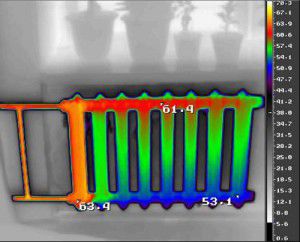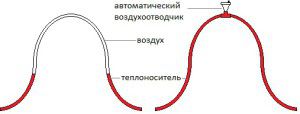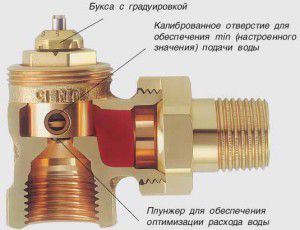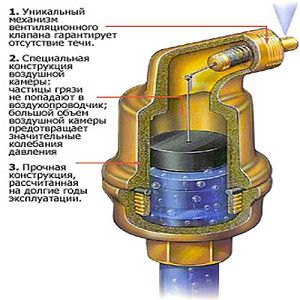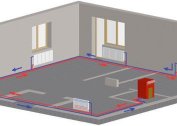Deterioration in heating performance can be due to several factors. One of them is airiness - the appearance of voids inside pipes and radiators. At the same time, the circulation of the coolant is difficult, the efficiency is significantly reduced and the risk of breakdowns increases. How to remove the air plug from the heating system in-house? To do this, you need to find out the main factors for the appearance of such a defect.
Causes of air congestion
A formed air lock in the heater can occur for a number of reasons. The main one is the coolant leak. Even a slight decrease in the volume of water in the system entails the formation of air gaps in pipes and radiators.
In addition, we must not forget that water is characterized by the degree of oxygen saturation. During heating, not only expansion occurs, but also steam is released. It can concentrate at the high points of the highway. Most often, an air plug in the heating radiator is formed precisely because of this. After the coolant cools down, its volume decreases, the resulting space is occupied by air. During operation of the system, in order to avoid the appearance of these phenomena, the following recommendations should be adhered to:
- Compliance with the level of arrangement of pipes and heating appliances. Even a slight skew of the battery will raise the question for the owner - how to drive the air plug out of the heating system;
- The use of system elements whose fabrication material does not allow oxygen molecules to pass through. The most common mistake is the installation of pipes made of cross-linked polyethylene without a protective sheath;
- Compliance with heating modes. This applies both to the temperature graph of operation and to pressure. To do this, mount pressure gauges and thermometers on critical sections of the highway;
- For closed systems, it is recommended that automatic replenishment of the coolant be installed. If even a small amount of water decreases due to leakage or evaporation, this mechanism will automatically add the required volume of coolant.
But how to break a cork in heating if it has already formed? First you need to find. A clear sign of its appearance will be a sharp decrease in temperature at a certain place in the pipeline or radiator. Characteristic sounds will also appear - gurgling and fluid flow. Slightly tapping will help to find the exact location of the defect. At this point, the metal will create slightly higher sounds than when fully filled with water.
If it is necessary to avoid a situation in which it will be difficult to remove the formed air plug from the heating pipes, it is recommended to install a separator after the boiler. This device reduces the gas content in the water.
Air congestion repair methods
Before you remove the air plug in the heating, you need to find out its properties. The main one is the density, which will always be lower than the same indicator of water. Accordingly, the liquid will displace air up and in the direction of circulation.
Therefore, to remove the air, you need to ensure the release of steam. To do this, install special devices - air vents and Mayevsky taps. They work on the principle of a check valve. When a certain pressure indicator is exceeded, steam acts on the valve seat. The rod moves, releasing air from the radiator or pipe.After normalizing the pressure under the action of the spring, the rod takes its old position.
An air plug in a cast iron or aluminum heating battery can damage the cabinet. Therefore, if such a situation arises, you need to immediately solve the problem.
Mayevsky crane
It is designed to eliminate air congestion in the heating battery. Despite its small size, the Majewski faucet contributes to the effective removal of accumulated steam not only in radiators, but also in pipes.
Structurally, it is a needle valve enclosed in a metal casing. How to remove the air plug from the heating system using it? First you need to decide on the model of the device.
Hand cranes
After installation in the upper radiator pipe, air is released after turning the union nut on the tap. Removing the air plug from the heating system using a Mayevsky hand crane is performed as follows:
- Filling the system with coolant. Cranes on radiators are in a closed state;
- When the maximum level is reached, the water supply stops;
- Having installed the required clearance of the needle stop in the devices, the cranes open;
- At the same time, the flow of coolant resumes.
Water is added to the system until fluid starts to flow from all of Maevsky’s taps. Be sure to check the absence of an air stream. This method is effective for removing air congestion in heating radiators at the first start-up of the system, before the season or when air pollution occurs during operation.
Manual models will effectively eliminate the air congestion in the radiator for both autonomous and central heating. The main thing is to choose the right mounting thread. In most cases, it is 1/2 ”, but there are models with a non-standard size 3/4”.
Automatic cranes
In contrast to the model described above, in their design, a saddle with a certain surface area is installed on the end of the needle valve. In combination with a return spring, the degree of compression of which determines the critical value of pressure at which the valve opens. The detailed device is designed to automatically break through the cork in heating when the critical temperature is exceeded and, as a consequence, the pressure.
However, before installation, you should familiarize yourself with the specifics of this model:
- To prevent water from entering the floor, a design must be provided for a pipe to drain excess water into the sewer;
- With prolonged stagnation, the valve seat may become calcareous, which will make it difficult to open. Therefore, it is recommended to open the tap manually once every 2-3 months. The steps of the procedure must be done before the first start of heating;
- The set maximum opening pressure must not exceed the critical value of the entire system. In order to remove the air plug from the heating in automatic mode, the pressure on the tap should be 5-10% less than the maximum.
Which is better to install: automatic or manual Maevsky crane? If the system does not provide for sudden pressure surges, manual models can be installed on radiators. For autonomous heating, automatic is preferred.
It is best to choose models made of brass. During the expulsion of the air congestion from the heating, they can withstand not only the critical value of pressure, but also temperature. Steel casing is susceptible to destruction and rusting.
Heating vent
But in addition to radiators, situations often arise when it is necessary to drive out the air plug from the heating system in the pipes. To do this, it is necessary to install air vents in certain sections of the highway.Their design is in many respects similar to the described Mayevsky automatic cranes. However, there are significant differences - they are designed for the largest amount of exhaust air and are installed not horizontally, but vertically.
In order to remove the formed air plug from the heating system, first you need to install the air vents in the right places:
- At the highest point of the highway. For an open system, this is only possible if a sealed expansion tank is installed on the return pipe;
- In collector heating - on each comb;
- For tee wiring - in front of each branch junction of the trunk.
After installation, you must correctly set the pressure value at which the air vent will work. To remove the air plug from the heating system, the coolant is pumped into the pipes until the air vent on the return line works.
When removing the air plug in autonomous heating, it is necessary to reduce the temperature of the coolant to a minimum. This will lead to a reduction in water volume and will contribute to more effective troubleshooting.
In combination with the functional qualities of Maevsky cranes, this makes it possible to effectively break through any plug in heating. It is important that the response parameters of devices do not exceed the critical pressure value. Otherwise, system security may be at risk.
The video shows an example of airing the radiator:
